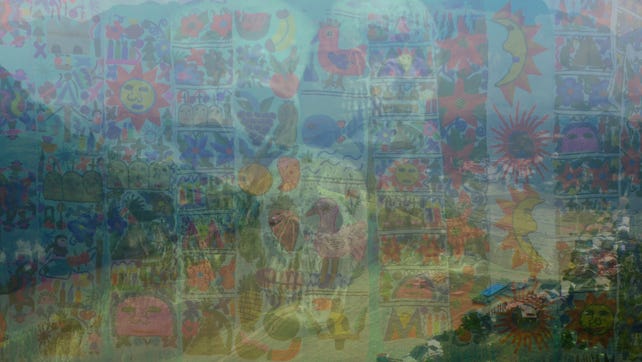La Llorona (Guatamalan) Movie Review
A powerful film about grief and the impact of genocide
Where to watch: AMC+
Trigger Warnings: genocide, violence, sexually explicit content
Non-Spoiler Synopsis: An aging former military general, supported by his wife and daughter, escapes punishment for his war crimes only for revenge to walk through his front door.
Ratings (out of 5) 😱😱😱
Jayro Bustamante and Lisandro Sánchez co-wrote the 2019 film "La Llorona," directed by Bustamante. This movie masterfully intertwines folklore with historical trauma, shedding light on the 1960 Guatemalan military genocide against the Mayan people. It hauntingly portrays the indigenous people's response to a general who evades accountability for his crimes during the trial.
Not only do we witness the general's growing paranoia, but we also see the impact of his deteriorating physical and mental health on his family. His daughter, granddaughter, and wife grapple with the horrifying truths about his actions and his true nature. Due to his crimes, all his staff quit except for one faithful servant who has been with the family since childhood. She manages to find a new young maid, but this newcomer is not what she seems.
The film also illuminates indigenous beliefs and the lasting impact of the genocide on the Mayan people.
Yes, this movie is heartbreaking, but it is also necessary. We often become isolated in our own small worlds; it is crucial to witness and understand the experiences of others.
**Spoilers ahead-read with caution**
“The bones are good witnesses, although they speak softly, they never lie and they never forget ." Dr. Clyde Snow
“La Llorona” poetically and heartbreakingly illuminates the genocide of the Mayan people in Guatemala.
The movie starts with the general’s trial. We witness the testimony of a survivor who shares how the general and his men ravished her village, killing livestock and burning homes, and how men and children were murdered. Women were raped. She shared how the survivors ran to the mountains and had to leave due to no food.
During his trial, it was exposed that 3,000 Mayan Ixil people were murdered a month, and 38% were children under 12.
The general is found guilty; however, due to his health, he is taken to the hospital, then home, and ultimately acquitted. His daughter, Natalia, tries to rationalize her father’s behavior by saying he only ordered the killings. He did not do it himself. His wife seems less convinced and grows more distant and disgusted with him.
Once he and his family return home, it is surrounded by protestors, holding pictures of their missing family members and signing. They do not leave. They stay night and day. They are representations of generational, historical trauma and grief. They are the survivors of genocide. Their protest is not only seeking justice and also to heal the community.
The household staff, primarily indigenous people, quit. Valeriana, the head housekeeper, stays on to tend to the family. We later learn the illegitimate daughter of the general. Alma shows up to work for the family. Her arrival stirs the general. He is attracted to her and afraid of her.
Natalia’s husband has been missing, and it is questioned: is he missing or a victim of the genocide?
Carmen, the general’s wife, starts to have nightmares of being with two young children and feeling like the military, only for her children to be taken from her, drown in front of her, and then the general to shoot her in the head.
The general, convinced that Alma is out to hurt him, believes she is the pool; he starts to shoot in the water, shooting his granddaughter in the arm. Waking from her nightmare, Carmen realizes that Alma is the woman in her dream. Valeriana starts to perform a ritual to free the spirits. Carmen chokes and kills the general. Alma has avenged her death, her children’s death, and the death of her people.
**end spoilers**
Dive deeper
“La Llorona” is a movie rich with traumatic loss, historical/generational trauma, and grief.
Traumatic loss, in its simplest form, involves the loss of a loved one in a traumatic way1. Traumatic grief can manifest as preoccupation with the deceased, feelings of longing and yearning, disbelief and an inability to accept the death, bitterness or anger about the circumstances of the death, and avoidance of reminders of the loss2. The impact of traumatic grief intensifies further when there is no body, and the status of the person being dead or alive remains unknown. This type of grief is prevalent in horror movies due to their nature, often depicting traumatic deaths. Revenge horror becomes a way for the main character to process their grief. They usually lose a loved one from a violent, traumatic death. These movies could be seen as the bereavement process, as the main character struggles to accept the loss, and we follow their journey to create meaning out of the loss.
Ambiguous loss, according to Boss (2002), is an unclear loss, traumatic loss and happens when either a loved one is physically present and mentally absent or physically absent and mentally absent3. Horror movies frequently depict both forms, showcasing scenarios where a family member is physically present yet mentally absent due to conditions like dementia or where a character grapples with the absence of a family member who remains mentally present. In horror movies, this can include a physically missing loved one that the main character may try to locate or a loved one with mental illness or addiction. Filmmakers often portray the mentally missing as someone with dementia.
Historical grief encompasses the sorrow stemming from historical traumas. Various factors, including maltreatment such as slavery, disenfranchisement of voting rights, lack of representation in positions of power, inconsistent access to medical care, and unequal access to education, profoundly influence grief experienced by marginalized communities. Other contributors include domestic terror, including lynching, police brutality, the weaponization of the criminal justice system, forced removal from their lands, the intentional dismantling of culturally relevant customs, the killing of unarmed Black men, and the separation of children from their families while seeking asylum at the border of Mexico4. In horror movies, they manifest as angry ghosts from the past or cursed lands. Historical grief and trauma representations in horror films can serve as a platform to raise awareness and pay homage to historical and generational grief, acknowledging its profound impact.
Final Screams and Thoughts
"La Llorona" masterfully intertwines the themes of traumatic and historical grief, using the horror genre to shed light on the profound and lasting impacts of genocide and systemic oppression. By depicting both the personal anguish of individuals and the collective sorrow of a marginalized community, the film serves as a poignant reminder of the resilience and enduring spirit of those who suffer such losses. Through the supernatural elements and the harrowing narrative of revenge and justice, "La Llorona" not only entertains but also educates and provokes critical reflection on the importance of confronting and acknowledging historical traumas. This film stands as a powerful testament to the necessity of healing and remembrance, offering a voice to the voiceless and honoring the memories of those lost to historical atrocities.
Want More?
Like folk horror films? Check out The Witch, The Ritual, Men; You Are Not My Mother.
Check out my review of Men
Men
Where to watch: MAX Content warning: suicide, death, attempted sexual assault, predator behaviors, body horror
Learn more about the Guatemalan Genocide:
https://sfi.usc.edu/collections/guatemalan
https://fafg.org/
https://vha.usc.edu/home
Coming soon:
movie review: You Are Not My Mother
Horror Movie Mental Health First Aid Kit
The Cathartic Release: How Revenge Horror Films Serve as an Outlet for Anger
Navigating your Nervous System with Horror Movies
Man Vs. Bear
Beyond the Grave: Grief in Horror Movies
New movie review on Wednesdays
Thoughts? Have you watched any of these movies? Movies you’d like me to review? Love to hear what your thoughts!
Disclaimer: The resources and information provided in this article are intended to offer support, guidance, and information to individuals seeking to enhance their mental well-being. However, it is essential to recognize that the information provided is not a substitute for professional therapy, counseling, or medical advice. While the materials included may offer valuable strategies and insights, they are not tailored to individual circumstances, and their effectiveness can vary from person to person. Mental health is a complex and deeply personal matter, and seeking the guidance of a qualified mental health professional is highly recommended for personalized assessment and treatment. By accessing and using the resources provided in this article, you acknowledge and understand that they are not a substitute for professional mental health services. The creators of this article are not liable for any consequences resulting from the use or misuse of the information provided. Remember, prioritizing your mental health and seeking professional help when needed are essential steps in your journey toward well-being.
Paul A. Boelen, Miranda Olff & Geert E. Smid (2019) Traumatic loss: Mental health consequences and implications for treatment and prevention, European Journal of Psychotraumatology, 10:1, 1591331, DOI: 10.1080/20008198.2019.1591331
Shear MK, Frank E, Foa E, Cherry C, Reynolds CF 3rd, Vander Bilt J, Masters S. Traumatic grief treatment: a pilot study. Am J Psychiatry. 2001 Sep;158(9):1506-8. doi: 10.1176/appi.ajp.158.9.1506. PMID: 11532739.
Boss, P. G. (2002). Ambiguous loss: Working with families of the missing*. Family Process, 41(1), 14–17. https://doi.org/10.1111/j.1545-5300.2002.40102000014.x
Blueford, J. M., & Adams, C. R. (2021). Trauma‐informed grief counseling with older BIPOC individuals. Adultspan Journal, 20(2), 111–124. https://doi.org/10.1002/adsp.12114









